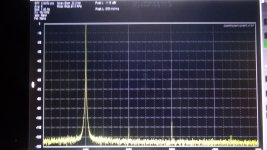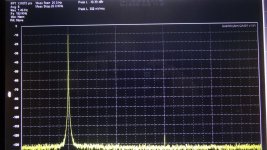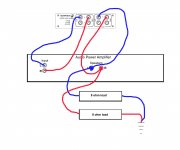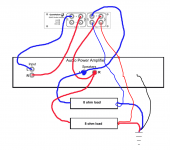Step one would be to short the QA401 input pins together at the dut. You should get essentially the residual plus any magnetic pickup in the cable.
Increase the front end range of the QA401 by......
Open the PDF for all of the notes
I have had several clients that have a needed to improve their use of the AP System One. Several want to add DSP to the system this can be done however it means that a scrapped 222 or 322 are needed to do this or just buy another AP. I have recommended that they buy a secondary device to work with the AP System. The AP is a GREAT FRONT END, it is all analog, full auto ranging and the bandwidth is > 500 kHz. By adding a QA400/QA401 to the monitor output (1 volt level) you can get a FFT display making the 22/22A a DSP measurement system.
Duke🙂
Open the PDF for all of the notes
I have had several clients that have a needed to improve their use of the AP System One. Several want to add DSP to the system this can be done however it means that a scrapped 222 or 322 are needed to do this or just buy another AP. I have recommended that they buy a secondary device to work with the AP System. The AP is a GREAT FRONT END, it is all analog, full auto ranging and the bandwidth is > 500 kHz. By adding a QA400/QA401 to the monitor output (1 volt level) you can get a FFT display making the 22/22A a DSP measurement system.
Duke🙂
Attachments
Nice write-up.
Is the AP monitor output you refer to an un-notched output, or is it the distortion output? Sounds like you are referring to the former, since you are using the term "front end".
If the former, what about using Jan's Auto-Scalar as a front end instead of the AP?
Cheers,
Bob
Is the AP monitor output you refer to an un-notched output, or is it the distortion output? Sounds like you are referring to the former, since you are using the term "front end".
If the former, what about using Jan's Auto-Scalar as a front end instead of the AP?
Cheers,
Bob
Hi Bob
The 3 BNC in the “MONITOR OUTPUTS” panel can be used to buffer the inputs to the QA401 or other device. Channel A and Channel B are full bandwidth no filtering. If the “READING” output is used it can do several things to alter the BW of signal depending on the setting of the analyzer.
The App note was written because of inquiries about updates to the AP. As I tried to say in the note “Think outside the box”. Look for solutions with equipment that you have first.
Jan’s Auto-Scalar is a very nice device. Jan is a very professional engineer and his product is a great front end that will work for QA401 or Sound cards.
Thank you for your comments. Duke
The 3 BNC in the “MONITOR OUTPUTS” panel can be used to buffer the inputs to the QA401 or other device. Channel A and Channel B are full bandwidth no filtering. If the “READING” output is used it can do several things to alter the BW of signal depending on the setting of the analyzer.
The App note was written because of inquiries about updates to the AP. As I tried to say in the note “Think outside the box”. Look for solutions with equipment that you have first.
Jan’s Auto-Scalar is a very nice device. Jan is a very professional engineer and his product is a great front end that will work for QA401 or Sound cards.
Thank you for your comments. Duke
Maybe someone who has experience with both can answer, as I have the chance to buy a used QA400:
Is there anything the QA400 does better than a good soundcard with ASIO + ARTA?
I have an Asus U7 with Win10 and an old Laptop running Win7 for use with an E-Mu 1616m. I am also thinking about getting a Scarlett 2i2 as an upgrade to the Asus on the Win10 machine.
The one thing the QA400 advertises is that it is separate from the Windows Sound system and that it offers absolute levels. So far, I must say, I have not run into any problems with other software changing gain or inserting processing when using ASIO and ARTA.
Also, in terms of analog performance, the 1616m with balanced input and a better ADC should be superior to the QA400.
Finally, does the QA400 get along nicely with Win10?
After all of this, is there still a killer rationale for getting the QA400?
Is there anything the QA400 does better than a good soundcard with ASIO + ARTA?
I have an Asus U7 with Win10 and an old Laptop running Win7 for use with an E-Mu 1616m. I am also thinking about getting a Scarlett 2i2 as an upgrade to the Asus on the Win10 machine.
The one thing the QA400 advertises is that it is separate from the Windows Sound system and that it offers absolute levels. So far, I must say, I have not run into any problems with other software changing gain or inserting processing when using ASIO and ARTA.
Also, in terms of analog performance, the 1616m with balanced input and a better ADC should be superior to the QA400.
Finally, does the QA400 get along nicely with Win10?
After all of this, is there still a killer rationale for getting the QA400?
Last edited:
After all of this, is there still a killer rationale for getting the QA400?
It does what it says on the box with the added bonus of being self contained, very easy to use and it's portable.
Happy with mine, feel money well spent. Works fine on Windows 7 after installation certificate issue was resolved so expect it'll be fine under Windows 10. Will upgrade to the QA401 eventually but there's no rush.
Also bought their QA190 differential probe for doing power amplifier measurements and poking around in unknown equipment, useful bit of kit.
The one thing the QA400 advertises is that it is separate from the Windows Sound system and that it offers absolute levels.
I don't see the advantage of not using the Windows Sound System. In fact, this means that you are locked in to the QA Windows software. You cannot use your preferred software or another operating system.
The typical set up with a soundcard + analyser software will also provide absolute levels (if the software knows how to do that, but most do).
I believe the QA400 is discontinued. The Qa401 is current and a quite nice unit. The integration with a decent software suite and internal data checking to make sure the link to the PC is not degrading the signals is useful.
That said if you have an Emu 1616m and you are adept with it you can use it with Arta and get to the same place for the most part. Add Jan's autoranger and you will have additional dynamic range on the inputs.
If this is your livelihood you should look at the cost vs. return of different solutions and throughput. However for DIY and Hobbiests learning how to use what you have should be the first issue. if you have nothing and don't want to learn all the intricacies of soundcards, drivers audio measurement software etc. the QA401 has a lot to recommend itself.
That said if you have an Emu 1616m and you are adept with it you can use it with Arta and get to the same place for the most part. Add Jan's autoranger and you will have additional dynamic range on the inputs.
If this is your livelihood you should look at the cost vs. return of different solutions and throughput. However for DIY and Hobbiests learning how to use what you have should be the first issue. if you have nothing and don't want to learn all the intricacies of soundcards, drivers audio measurement software etc. the QA401 has a lot to recommend itself.
Thanks. I know that the 401 is quite good, but also pricy. I happen to have a chance to buy a used 400 and was wondering if I would have a significant benefit. No serial testing, by the way.
If you have the 1616m make some cables. Learn Arta and have a great day. You will be able to make almost any test any of the other systems can do. The noise and distortion floor difference are not significant in most applications. Where they are you will quickly need to go to the SOTA solutions like AP2272 or Shibasoku 725.
Small revisions in drawing.
1) Use differential connections for the output of the amp
How so? Redraw diagram. Confusion grows...
Hi Demian,
I'd remove the ground connection in the diagram to show that the currents return to the amplifier explicitly. Otherwise, that is how I take my measurements.
-Chris
I'd remove the ground connection in the diagram to show that the currents return to the amplifier explicitly. Otherwise, that is how I take my measurements.
-Chris
You can place 8 x 1 ohm and only take the potential from 1 ohm to get lower distortion results.
Hi gabdx,
I don't understand what you are doing. Can you make a small sketch and post it?
-Chris
I don't understand what you are doing. Can you make a small sketch and post it?
-Chris
You can place 8 x 1 ohm and only take the potential from 1 ohm to get lower distortion results.
Yeah, and lower signal results. The QA401 already has the necessary pad built in and will handle 30VRMS as Demian mentioned.
The ground scheme on the modified drawing might be a little confusing, but it's correct. There's no ground connection to remove, per se.
Dave.
Like most ADC - when you get to -100dbv and below, the accuracy starts to fall apart -
Same with QA400/401
Without pad, at 0dbv, the 2H starts to show from the FFT analyzer.

and with -10 input --

Whereas, the 2H and 3H are actually about the same with more accurate analyzers;
The AP 2722 and ShibaSoku 725D both show the 2H and 3H at almost same level with this generator source.
Anything below about -105 should be ignored as an absolute with QA . However it is still much better ( approx. 20db) than some popular sound cards at same level.
THx-RNMarsh
Same with QA400/401
Without pad, at 0dbv, the 2H starts to show from the FFT analyzer.

and with -10 input --

Whereas, the 2H and 3H are actually about the same with more accurate analyzers;
The AP 2722 and ShibaSoku 725D both show the 2H and 3H at almost same level with this generator source.
Anything below about -105 should be ignored as an absolute with QA . However it is still much better ( approx. 20db) than some popular sound cards at same level.
THx-RNMarsh
Last edited:
QA101 is also very great to have, arbitrary generator and so many important testing, it can take more input voltage than the QA400.
If you read carefully the QA401, it is designed for 56VPP with the attenuator in action. I don't use the built in attenuator because it changes something to the measurements. Any padding is more complicated than a divider because of input capacitance and the way it is designed.
without attenuator 56Vpp - 20 db is around 17Vpp , = 6Vrms, P=6*6/8 = 4.5Watt.
True for white noise. For signals at -105 the machine is overloaded.
If you read carefully the QA401, it is designed for 56VPP with the attenuator in action. I don't use the built in attenuator because it changes something to the measurements. Any padding is more complicated than a divider because of input capacitance and the way it is designed.
without attenuator 56Vpp - 20 db is around 17Vpp , = 6Vrms, P=6*6/8 = 4.5Watt.
True for white noise. For signals at -105 the machine is overloaded.
- Home
- Design & Build
- Equipment & Tools
- QuantAsylum QA400 and QA401

